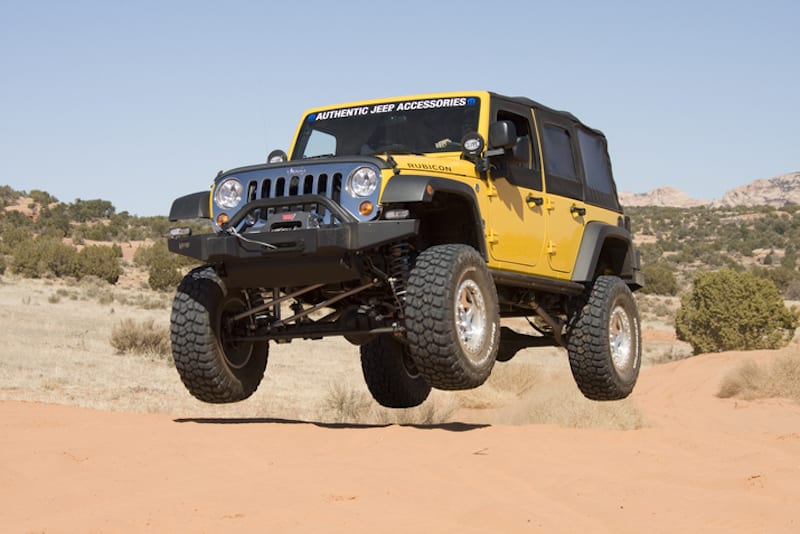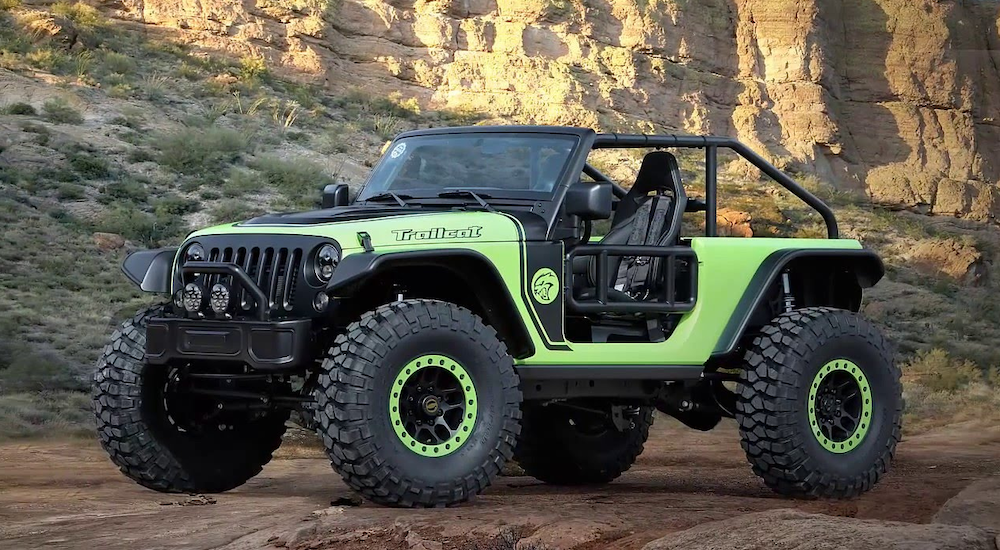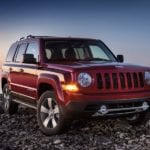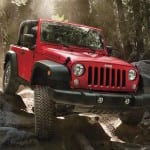Jeep lovers know that the true value of a great Jeep comes from the content of its character; that is to say, it’s the unique touches on each Jeep that gives that specific vehicle its individual charm. Proud Jeepers know that to craft your own Jeep, you need to find your own style – and the best way to do that is with modifications, upgrades, and additions, the subtle combination of which sets each Jeep apart from one another.
Fortunately, Jeep has caught on to this and responded with gusto, offering a huge selection of available accessories, and by making their vehicles more and more easily customizable. Combine that with an ever-growing selection of aftermarket parts and the possibilities for uniquely styling your used Jeep Wrangler become seemingly limitless.
Here are some of the most popular and most impressive Jeep mods available for your Wrangler today. Take a look, and maybe you’ll find your Jeep’s next new part.
Suspension Systems To Spring Into Serious Action
Nothing gives your Jeep the boost it needs to crawl rocks and slosh through streams quite liked a heavy duty, lifted suspension system. This is usually a first stop for a serious modder, and a good way to drastically increase your Jeep’s offroading abilities by increasing the clearance beneath the main cab and ability to take on tough climbs.
Whether you choose to lift or lower your Jeep, or to go with offroad-ready suspension or a system more apt for towing, any upgrades to your Jeep’s suspension system can seriously increase your vehicle’s capabilities as a tough worker.
Tires, For Total Traction on Terrible Terrain
Once you’ve got enough suspension height to fit them, it’s time to start thinking about some massive offroading tires.
Now, to be fair, your Jeep is likely going to come with some powerful all-terrain tires that are perfectly fine for your daily driver or some light dirt driving, but if you’re looking to get into some serious offroading you should consider some snow or mud tires to guarantee traction on uneven surfaces. These can make the difference between having a steady footing on icy or muddy surfaces and just spinning in place.
And for those looking to take on the most intense rock climbs or the sludgiest mud pits, look no further than some enormous swamper tires. Built with massive channels for improved traction even in inches of mud and water, these tires promise total traction in just about any situation you find yourself in. Of course, they won’t do too much good without…
A Locking Differential For Optimized Crawling
Normally, when one of two wheels on an axle encounters increased or decreased resistance, the vehicle will automatically work to preserve uniform torque by allowing one wheel to spin faster or slower than another. This is critical to turning effectively but doesn’t really work while offroading because it sacrifices traction for torque.
On a locking differential, however, the wheels are locked to spin at the same speed no matter what kind of resistance they each meet. When climbing rocks or powering through slick areas, this can greatly improve traction.
If you’ve bought a Rubicon or one of several special edition Wranglers, you probably already have a differential locker standard on your vehicle. For the rest of us, this is an available addition that can make a serious difference out on the trail.
Winches, For All That Pulling
Plenty of Jeep owners will go through their entire ownership of their Jeep and never once even consider getting a winch installed on the front grille. Other Jeep drivers might not even be able to imagine having a Jeep without a winch; it really depends on what you’re going to be using your Jeep for, and how often you plan on using it.
It you plan on taking your Jeep on all of the rough, muddy terrains you can find, then getting a winch is definitely in your best interest. This strong tow line can be just the thing that yanks your Jeep out of the muddiest of mud pits one day, and being able to pull your friends out of the snow and sand isn’t a bad skill to have either. Let’s put it this way: if you decide to install one, we highly doubt you’ll be disappointed with your winch.
Rock Sliders and Side Rails
Considered necessary by some Jeepers, rock sliders are essentially the last line of defense between your precious Jeep’s side panels and the grinding of rocks underneath. For those who use their Jeep for serious rock crawling, rock sliders are absolutely critical to protecting the precious machine. Plus, they typically double as side steps for easy entry, especially useful on models with lifted suspension systems.
And, best of all, these side rails can serve as a secure tow point in case of rollovers, and can protect against regular sideswiping on the road or in the parking lot later on.
Heat Extractor Hoods To Keep Everything Cool
Long periods of high performance – like climbing a craggy mountain or powering through the muck – can generate a lot of heat under the hood, which can damage your engine after long periods of duress. Adding a functional Heat Extractor Hood or a high-flow air scoop can release that hot underbody air from the engine block and cycle in fresh, cool air to the radiator. This not only improves engine performance but helps maintain the condition of your motor for much longer in the long run.
Plus, they look really cool – with accented scoops and a muscular design, these heat extractor hoods give your Jeep that heavy sport looks without sacrificing even an ounce of Jeep toughness.
Lights To Guide The Way
Whether you’re out in the middle of the woods or cruising down the highway at night, it’s critical that you can see in the dark from your Wrangler. While many Wrangler models come with excellent standard headlights, upgrading to LED replacements with halogen fog lamps can seriously improve your Jeep’s nighttime visibility. Plus with plenty of lighting bars and additional hood-mounted headlamps available, you can make sure everybody else can see you as easily as you can see them.
For those tired of having to chip snow and ice off of frozen headlamps, several options also come heated to melt away that ice as soon as the engine gets started.
Performance Chips To Supercharge Your Engine
Sometimes, all the power of Jeep’s mighty standard engines simply isn’t enough to take on those seriously tough trails. For those instances, Jeepers should look to additional performance chips to maximize performance where it matters most.
Many of these systems come as aftermarket parts from professionals who specialize in such technology. That means these are carefully calibrated to maximize everything from torque and traction to fluid pressure and temperature. For the Jeeper seriously concerned with performance, having a performance chip is a bit of a no-brainer.
These are only some of the fantastic upgrades available for your Jeep today. Whether you plan on hitting the trails with your faithful Wrangler or simply want a couple of additions to show off to the neighbors, Jeep offers plenty of options to make your Wrangler uniquely yours. Check out what’s available, and get building on yours today.
Update 6/13/2019
It’s always interesting to revisit an article from a few years back. Here we are, fast approaching the midpoint of 2019, looking back on our work from three years ago and thinking of how much has changed across the automotive landscape. Across the board, we’ve witnessed commitments to a fully-electrified future. We’ve seen developments in hydrogen-based fuel cell engines and staggering advances in self-driving technologies. More accessible are the strides we’ve seen in the weight reduction of trucks, and the near-elimination of the economy sedan. In a relatively short time, it’s become a significantly different world unless of course, we’re talking about Jeep mods.
Sure you could argue that the introduction of both the JL and the Gladiator equate to massive changes in the Jeep arena, and we’d be hard-pressed to disagree. But the simple truth is that options for mods are largely indifferent from what they were three years ago. So where do we go from here in terms of this discussion?
I suppose we could talk about updates to lift kits, new tire offerings and protective add-ons that have made their way into the marketplace. But, then again, Jeep ideology wasn’t built on staying the course of well-paved roads; it was designed to stray aimlessly on less-traveled paths, in an unapologetic search for adventure. And with that in mind, let’s shift our focus from the kind of easy upgrades that are obvious to the most ignorant of noobs. In this piece, let’s talk about true performance upgrades courtesy of seven items we’d list atop our list of mods that everyone needs to consider (sooner, rather than later).
Supercharger
One of the ultimate end-around to achieving better performance ratings without increasing the size of an engine comes in the form of a forced induction (be it by a Turbocharger or) from a Supercharger. Powered by the crankshaft, a Supercharged engine generates more power by pressurizing the air intake so that it’s more potent than the surrounding atmosphere. As a result, each engine cycle enjoys increased oxygen flow, increasing the rate of fuel burn and generating greater output.
Air Intake
Above we talk about increasing air flow to drive up performance numbers; well, an upgraded air intake system boosts that goal to a whole new level. Consider for a moment, the important role that oxygen plays within any combustion engine. But that importance isn’t limited to the quantity of oxygen, but also the quality of that oxygen. And thus, air filters are a mainstay of most any vehicle designed to help reduce particle intake, despite a minor risk of reduction in actual intake. An aftermarket cold air intake is designed with two primary goal in-mind (i) to offer a larger intake opening, allowing for a greater pull of oxygen and (ii) maintain a high-level of filtration despite being less restrictive in its design. Cool air, of course, is dense…so the intake allows for greater output and improved performance. A traditional cold air intake, paired with the right exhaust system, might boost a vehicle’s horsepower by 1-5 horsepower while increasing fuel economy by 1-2 mpg.
Larger Throttle Body
By now, even a relative newcomer under the hood understands that air flow ranks pretty high in terms of the elements which influence your vehicle’s performance. And while an aftermarket air intake might only offer a modest increase in horsepower, the inclusion of a larger-diameter throttle body could pump those numbers up to the tune of 25 hp. Of course, there are very few surprises as to how it manages to achieve this since its name is rather self-explanatory. Being larger it allows for even greater air intake. Nice and simple right?
Throttle Body Spacer
Another component in facilitating a superior flow of cool, dense air is the Throttle Body Spacer – a relatively simple installation of a downflow device that lifts the throttle body a small amount while yielding a notable difference in airflow to the intake manifold. The results include improved fuel economy, horsepower and torque thanks to a spiral air flow that accelerates the intensity level of the combustion engine.
Tuner
Unlike some of the above, an aftermarket tuner is a bit more of a niche item albeit one that some consider to be instrumental for anyone looking to drive up horsepower in a Wrangler. Credited with triple-digit gains in both horsepower and torque, the potential of any tuner depends largely on the brand and model chosen, as well as its compatibility with the vehicle as it stands. That said, the ability to switch drive modes is empowering for anyone interested in customizing their vehicle’s performance, especially if they’re not personally restricted to just one style of driving.
Catback Exhaust
What’s in a name? Well, a catback exhaust is named for its placement at the back of the exhaust. That said, the system – when paired with a high-flow aftermarket catalytic converter – replaces stock exhaust components to ramp up airflow, torque, and horsepower through a more efficient, and far more direct design.
Aftermarket Headers
Having repeatedly emphasized the important role of air flow, its important to recognize the inherent limitations of stock exhaust manifolds. An aftermarket exhaust header can have a significant impact on air flow, improving efficiency, increasing horsepower and generating valuable supplemental torque. The respective benefits of short and long-tube headers differ based on the unique needs of each driver. Shorty headers are designed to generate greater horsepower and torque ratings at lower RPMs while long-tube headers operate best at mid to high RPMs.
Get Under That Hood to Add Value
It’s easy to look at ways to enhance your vehicle’s exterior, but putting in the actual effort required to improve its performance can prove intimidating to some (especially if they lack automotive know-how).
That said, you’re robbing yourself twice if you lack a willingness to let your Jeep be everything it could be. First, you’re robbing yourself of the opportunity to enjoy the best possible version of your vehicle. Second, you’re not doing as much as you could to secure a greater return on your original investment something down the road when you make the decision to sell. Ultimately, the choice is yours.
But if you’re really interested in maximizing the value of your Jeep, plan to dig a little bit deeper. Exterior mods and upgrades to suspension and tires will certainly work in your favor when it comes to driving valuation, but you should make sure that Jeep of yours runs just as badass as it looks.









